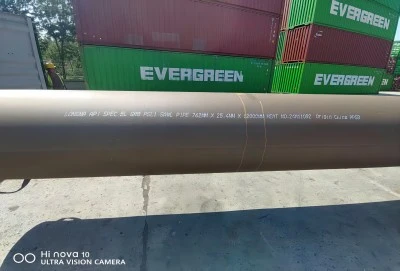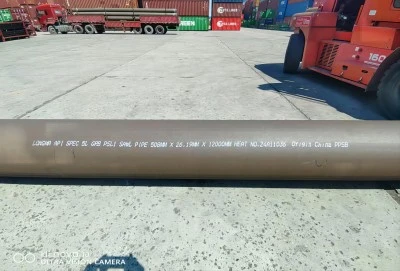In the oil and gas industry, the integrity and efficiency of pipeline systems are paramount. One crucial aspect that often goes unnoticed but plays a significant role in ensuring these qualities is the API line pipe thread angle. This article delves into its thread angles, their impact on pipeline connections, and the standards set by API 5L. Whether you're an industry professional or simply curious about the technical aspects of pipeline systems, this comprehensive guide will provide valuable insights into this critical component.
|
|
|
What is the API Line Pipe Thread Angle?
The API line pipe thread angle refers to the specific angle at which the threads on API line pipes are cut. These threads are essential for creating secure connections between pipe sections in oil and gas pipelines. The thread angle is a critical factor in determining the strength, sealing capability, and overall performance of the pipe connection.
API line pipes typically use a thread angle of 60 degrees. This angle has been carefully determined through years of research and practical application to provide the optimal balance between ease of assembly and connection strength. The 60-degree thread angle allows for a deeper thread engagement, which translates to a more robust and leak-resistant connection.
It's important to note that the thread angle is just one component of the overall thread profile. Other factors, such as thread pitch, taper, and root and crest geometry, also play crucial roles in the performance of API line pipe connections. However, the thread angle serves as the foundation upon which these other elements are built.
How Does the API Thread Angle Affect the Performance of Pipeline Connection?
The API thread angle significantly influences several aspects of pipeline connection performance:
- Sealing Capability: The 60-degree thread angle provides an excellent sealing surface. As the male and female threads are tightened together, the angled surfaces create a metal-to-metal seal that becomes increasingly tight as more torque is applied. This seal is crucial for preventing leaks in high-pressure pipeline systems.
- Load Distribution: The thread angle affects how loads are distributed across the connection. The 60-degree angle allows for a more even distribution of both axial and radial loads, reducing stress concentrations that could lead to premature failure.
- Ease of Assembly: While a steeper angle might provide a tighter seal, it would also make assembly more difficult and increase the risk of cross-threading. The 60-degree angle strikes a balance, allowing for relatively easy assembly while still maintaining excellent sealing properties.
- Resistance to Galling: Galling is a form of wear caused by adhesion between sliding surfaces. The 60-degree thread angle helps minimize galling by reducing the surface area in contact during assembly, thereby decreasing the likelihood of metal-to-metal adhesion.
- Fatigue Resistance: In dynamic loading conditions, such as those experienced in offshore pipelines, the thread angle plays a role in fatigue resistance. The 60-degree angle provides a good compromise between stress distribution and thread engagement, contributing to improved fatigue life of the connection.
Understanding these effects is crucial for engineers and operators involved in pipeline design, installation, and maintenance. The thread angle's impact on these performance factors underscores its importance in ensuring the safety, efficiency, and longevity of pipeline systems.
What are the Requirements of API 5L Standard for Thread Angle?
The API 5L standard, which governs the specification for line pipe, sets forth specific requirements for thread angles and other thread characteristics. While the standard covers a wide range of pipe specifications, it's important to note that not all API 5L pipes are threaded. Many large-diameter pipes used in transmission pipelines are joined by welding rather than threading.
For those API 5L pipes that do use threaded connections, the standard typically refers to other API specifications for detailed threading requirements. These include:
- API Spec 5B: This specification covers threading, gauging, and thread inspection of casing, tubing, and line pipe threads. It specifies the 60-degree thread angle as the standard for API line pipe threads.
- API Spec 5L: While this is the primary specification for line pipe, it often defers to API 5B for specific threading requirements. It does, however, provide guidelines on thread length, taper, and other dimensional aspects that relate to the thread angle.
- Tolerance: The API standards typically allow for a small tolerance in the thread angle. While 60 degrees is the nominal angle, a slight variation (usually within ±1 degree) is permitted to account for manufacturing tolerances.
- Inspection: The API 5L standard requires that threaded pipe ends be inspected to ensure compliance with the specified thread form, which includes the thread angle. This inspection is crucial for maintaining the quality and reliability of threaded connections.
It's worth noting that while the 60-degree thread angle is standard for API line pipe, other thread forms exist for specific applications. For instance, some premium connections used in challenging environments might employ proprietary thread designs with different angles. However, these are typically covered under separate specifications and are not part of the standard API 5L requirements.
Adherence to these standards is crucial for ensuring interchangeability of pipes and fittings from different manufacturers, as well as maintaining the integrity and performance of pipeline systems. Manufacturers of API line pipes must rigorously follow these specifications and undergo regular audits to maintain their API certification.
Contact Longma
The API pipe thread angle, while seemingly a small detail, plays a crucial role in the performance and reliability of pipeline connections. Its impact on sealing capability, load distribution, ease of assembly, and overall connection strength makes it a critical consideration in pipeline design and operation.
Understanding the nuances of thread angles and their effects can help engineers and operators make informed decisions about pipe selection, installation procedures, and maintenance practices. As the oil and gas industry continues to push the boundaries of exploration and production, the importance of these technical details only grows.
At Longma Group, we understand the critical nature of every component in your pipeline systems. Our line pipes are manufactured to the highest standards, ensuring precise thread angles and exceptional performance. Whether you're embarking on a new pipeline project or looking to upgrade existing infrastructure, our team of experts is here to help. Contact us at info@longma-group.com to discuss your specific needs and how our high-quality API line pipes can contribute to the success of your operations.














